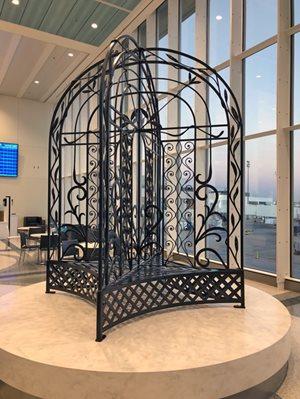Philip Simmons
Philip Simmons was born June 9, 1912, in Wando on Daniel Island, near Mount Pleasant, South Carolina, where he was reared by his grandparents. At age 8, he was sent to Charleston (via the ferry), to live with his mother on Vernon Street and enroll in the first class at Buist School
At the time, the school on Daniel Island offered limited education because it was an agriculture and fishing community. It was open for only three months and teachers were difficult to keep.
While walking to and from school young Philip noticed the ironwork and became intrigued with it. The neighborhood was a Mecca for craftsmen who serviced the waterfront businesses. He began visiting the blacksmith shops, pipefitters, shipwrights, coppers, and other craftsmen in the area. However, the sounds of the blacksmith shops interested him the most.
Simmons was the most celebrated of Charleston ironworkers of the 20th Century. He received his most important education from local blacksmith Peter Simmons (no relation), who ran a busy shop at the foot of Calhoun Street. It was in that environment where Philip Simmons acquired the values and refined the talents that would sustain him throughout his long metalworking career.
Moving into the specialized fields of ornamental iron in 1938, Simmons fashioned more than 500 decorative pieces of ornamental wrought iron: gates, fences, balconies, and window grills. The city of Charleston from end to end is truly decorated by his hand.


In 1982, the National Endowment for the Arts awarded him its National Heritage Fellowship, the highest honor that the United States can bestow on a traditional artist. This recognition was followed by a similar award from the South Carolina state legislature for “lifetime achievement” and commissions for public sculptures by the South Carolina State Museum and the city of Charleston. Simmons was inducted into the South Carolina Hall of Fame in Myrtle Beach, SC on January 31, 1994. “The Order of the Palmetto”, South Carolina’s highest award, was presented to him on August 11, 1998 by Governor David Beasley. In 2001, Philip Simmons received the Elizabeth O'Neill Verner Governor's Award for “Lifetime Achievement in the Arts.” And on May 12, 2006, he was the recipient of the Honorary Doctorate of Fine Arts by South Carolina State University in Orangeburg.
In 2004, Simmons was commissioned by the Charleston County Aviation Authority to create an ironwork display for the airport. From a pencil sketch (above), the iron gazebo in the Central Marketplace (after security) was created. The gazebo serves as a reminder of Charleston's rich history and Simmons' place in creating art that has become synonymous with the Holy City.
Five years after he conceived the airport gazebo, Simmons passed away in 2009.
Biography Source: Philip Simmons Foundation
Pencil sketch used with permission from the Avery Research Center at the College of Charleston.
Headshot: Claire Y. Greene ©1993 with permission from the Philip Simmons Foundation, Inc.
Learn more about Philip Simmons in this video from South Carolina ETV: